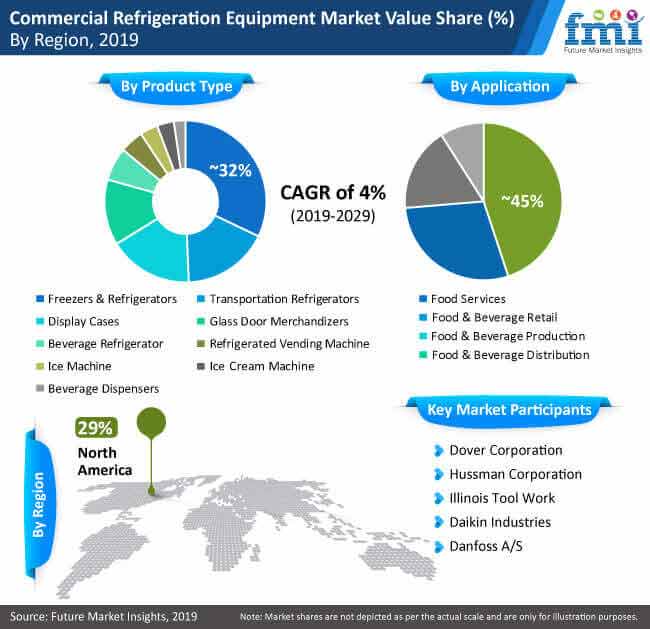Witnessing an uptick of 3.4% over 2018, the worldwide sales of commercial refrigeration equipment will exceed revenues worth US$ 46 Bn by 2019 end. As indicated by a recent research study of Future Market Insights (FMI), the market for commercial refrigeration equipment will progress at a moderate CAGR over 2019 – 2029. The demand would be prominently driven by greater production of F&B goods and a preferential shift of consumers towards quick service restaurants (QSRs), at a global level.
Request a FREE Sample of this Report in PDF: https://www.futuremarketinsights.com/reports/sample/rep-us-1305
Sustainable and energy-efficient refrigeration systems are set to become a norm across the end-use industries, which should compel manufacturers to increase their investments in R&D and product innovations. Leveraging energy-efficient technologies to offer low global warming potential (GWP) products with rich functionalities will be the ticket to capturing significant market share in the long run.
COMMERCIAL REFRIGERATION EQUIPMENT MARKET KEY TAKEAWAYS
- Growing demand for ready-to-eat products and expanding retail outlets are driving the sales of commercial refrigeration equipment.
- North America and Europe would collectively account for over half of the market value share by 2029 end.
- The food services sector will remain prominent application area to invest in, for commercial refrigeration equipment market players.
- The enforcement of new refrigerant regulations such as the EPA 680 Upgrade, and the Kigali Amendment for the phase-down of HFC refrigerants will largely impact the market growth.
- The higher average unit cost of freezers & refrigerators allude lower volume sales vis-à-vis value gains, with just about 2.6 million unit sales in 2018.
- Glass door merchandizers that account for around a third of total volume sales continue to see relatively low revenue generation as compared to freezers & refrigerators.
- Sales of beverage dispensers and display cases across end-use industries will show a moderate increase year-over-year in 2019, which will collectively represent nearly 16% of total commercial refrigeration equipment sales in that year.
Request a Complete TOC of this Report with figures: https://www.futuremarketinsights.com/toc/rep-us-1305
Manufacturers who are keeping the innovation quotient high and providing turn-key solutions to meet regulatory requirements, with safety to end users at the core, will be rewarded in the long run.
Chinese Players Striving to Win Home Market
In developed markets, rapid acceptance of alternative refrigerants to benefit from regulatory standards along with expansion of F&B processing industries continue to contribute to the development of the commercial refrigeration equipment market. The growth of Asia Pacific’s commercial refrigeration equipment market was influenced by a shift of Asian eating habits towards western-style convenience food. With the ability to manufacture their own compressors, Chinese companies are gaining competitive edge to reign supreme in their home market with indigenous brands.
Competition Trends
In 2018, the top four stakeholders including Carrier Corporation, Daikin Industries, Ltd., Danfoss A/S, and Hussman Corporation collectively accounted for 20-25% revenue share. The emergence of a large number of small players in developing countries has resulted into price competition, with leading market players losing their profit margins. Market fragmentation will continue through 2029, driven by regional regulatory norms and enhanced capabilities of the local players.
Ask us your Any Queries About this Report: https://www.futuremarketinsights.com/askus/rep-us-1305
Learn More About What the Report Covers
This FMI report is an extensive analysis of the global commercial refrigeration equipment market that offers actionable insights on how the market growth will unfold over the forecast period, 2019 – 2029. The market for commercial refrigeration equipment has been categorized into various segments, for analysis, on the basis of the type of refrigeration equipment, application area, and region. The study provides valued information on key competition trends and most preferred developmental strategies of leading market brands

